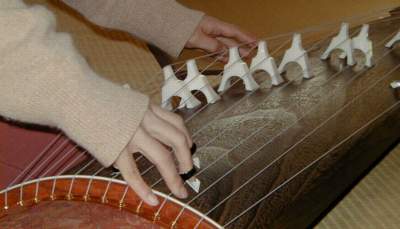|
The
KOTO
|
|

The Koto
is an ancient Japanese instrument that is still played today, although
it's not nearly as popular as in the past. The sound is very interesting,
not rhythmic in the way you may expect, but it's definitely got a twang!
Most Japanese don't listen to it much,because it is so traditional. Of
course, some like it, but most prefer pop music! I guess it's like Classical
music, you've gotta develop an ear for it. The instrument has a long hollow
wooden body, with two holes underneath. It has 13 thick nylon strings
(they used to be made of silk), and 13 movable bridges. The strings are
basically pulled taught and tied, and the tuning is done by moving the
bridges. In fact, a koto may be re-tuned for each song! Some songs require
a higher scale, so the bridges are moved toward the player, and for a
lower pitched song the strings are moved away from the player. I asked,
"what if adjacent bridges must be next to each other for the proper
tuning, and get in each others way because they are so big?" Hana
said that happened when she tuned today, and she should loosen the knot
and adjust the tension, but she was going to accept it a little out of
tune, because she was afraid to loosen the string.  Playing
the Koto involves laying the instrument on the floor and sitting next
to it. You use your right hand to pluck the strings, and your left hand
to pull or push the strings to get a "whaa-whaa" effect. Ivory
clips are usually worn on the thumb, pointer and middle fingers of the
right hand to give a louder sound and for other benefits. Hana uses square
ivory picks, but other schools of koto use rounded ones. Many Koto songs
are relatively slow tempo, requiring the player to carefully time long
pauses. Some songs are faster and involve techniques similar to strumming.
A beginner's practice koto may be as cheap as US$500, but very nice ones
may cost US$7,000 or more.
Playing
the Koto involves laying the instrument on the floor and sitting next
to it. You use your right hand to pluck the strings, and your left hand
to pull or push the strings to get a "whaa-whaa" effect. Ivory
clips are usually worn on the thumb, pointer and middle fingers of the
right hand to give a louder sound and for other benefits. Hana uses square
ivory picks, but other schools of koto use rounded ones. Many Koto songs
are relatively slow tempo, requiring the player to carefully time long
pauses. Some songs are faster and involve techniques similar to strumming.
A beginner's practice koto may be as cheap as US$500, but very nice ones
may cost US$7,000 or more.
 I
was interested to try my hand at it (of course), and found it quite relaxing,
even therapeutic! The pauses are the key, I think! I don't know that I
have the patience to study it for three years, like Hana has, but I enjoyed
it for a couple minutes... I thought it was interesting to see the music
she reads from to play the Koto.
I
was interested to try my hand at it (of course), and found it quite relaxing,
even therapeutic! The pauses are the key, I think! I don't know that I
have the patience to study it for three years, like Hana has, but I enjoyed
it for a couple minutes... I thought it was interesting to see the music
she reads from to play the Koto. This is the first page of "Sakura" (means Cherry Blossom) Basically,
each square represents four counts, and the characters are the numbers
of the strings you should twang for that count. Sounds simple, huh?? You
read from top to bottom, starting on the right side. The audio clip below
is the first 13 or 14 squares on this page.. in case you want to read
along!
This is the first page of "Sakura" (means Cherry Blossom) Basically,
each square represents four counts, and the characters are the numbers
of the strings you should twang for that count. Sounds simple, huh?? You
read from top to bottom, starting on the right side. The audio clip below
is the first 13 or 14 squares on this page.. in case you want to read
along!
It is not extremely common to play the Koto, but Hana started playing in college, and continues to play as a hobby. Chino HS supports her talent, and sponsors a Koto Club, dedicated students who meet after school and learn to play from Hana. Unfortunately, currently there are no members! There are 4 Kotos though, so if you are interested...
Hana also plays the shakuhachi which is a bamboo flute, and the Shamisen which is a stringed instrument played like a guitar, but made of cat (or dog or snake) skin stretched over a wooden frame. I'll try to get her to play one of those for you!
Here are clips of two songs she played. Both are only a short part of
the full song, but will surely give you a taste of Koto. Sakura means
"cherry blossom" which is the flower on the cherry tree, and
is incredibly popular here (both the song and the flower). Rokudan is
also one of the most popular and well known koto songs. It means "six
parts" of which Hana played the first. They are in mp3 format which
should play on either Mac or Windows machines. Let me know if you have
any trouble playing these.
|
Sakura
(Cherry Blossem) |
Rokudan
(Six Parts)
2:25 - - 568K |
